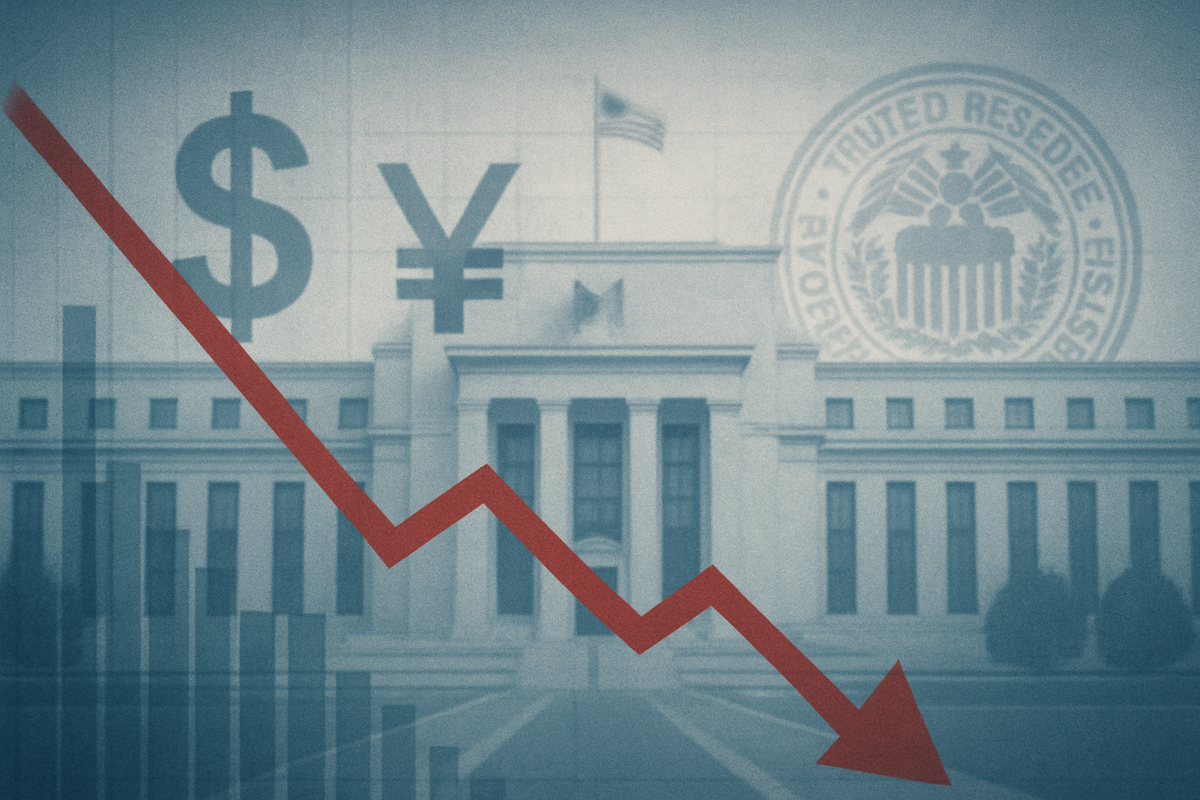
Recent weak labor market data in the United States has significantly amplified market expectations for a Federal Reserve interest rate cut in December 2025. This growing conviction for a more dovish Fed stance is exerting considerable downward pressure on the US dollar across global currency markets, signaling a potential shift in monetary policy that could have far-reaching implications for investors and consumers alike.
The immediate fallout of these developments is particularly evident in currency markets, where the US dollar (USD) is broadly weakening against a basket of major currencies. While a softer dollar typically suggests a decline in the USD/JPY pair, the dynamics are proving more complex due to the Bank of Japan's (BoJ) persistently accommodative monetary policy. Traders are now closely scrutinizing key resistance levels for the USD/JPY pair, as the interplay between a potentially dovish Fed and an ultra-loose BoJ creates a volatile and uncertain environment.
Weak US Labor Data Bolsters Case for December Rate Cut
The narrative of a robust U.S. labor market has been challenged by a series of recent economic indicators, collectively pointing towards a significant cooling and strengthening the case for a Federal Reserve rate cut by December 2025. The most recent data paints a picture of a weakening employment landscape, diverging from earlier expectations of sustained strength.
Specific details contributing to this shift include reports from ADP, which indicated that US private employers shed an average of 11,250 jobs per week in the four weeks ending October 25, 2025. This private-sector data has gained increased prominence due to delays in official Bureau of Labor Statistics (BLS) reports, a consequence of a recent US government shutdown. Further compounding the concerns, the broader October 2025 jobs report showed payrolls slowing to 150,000, falling short of market forecasts. Adding to the apprehension, the Challenger Job Cuts report for October 2025 revealed a staggering 153,074 job cuts, marking the highest monthly total since 2003 and representing the largest year-to-date cuts (excluding 2020) since the Global Financial Crisis in 2009. This weakening labor outlook is further underscored by a six-month low in the US October NFIB small business optimism index.
The timeline of events leading up to this moment has seen a gradual accumulation of data suggesting economic deceleration. For months, the Federal Reserve (Fed) had maintained a hawkish stance, battling inflation with a series of interest rate hikes. However, signs of economic fatigue began to emerge in late summer and early autumn 2025, with manufacturing and service sector indices showing signs of contraction and consumer spending moderating. The recent spate of weak labor data, culminating in the October reports, has served as a critical turning point, shifting market sentiment decisively towards a dovish pivot by the Fed. Key players involved include the Federal Reserve's Federal Open Market Committee (FOMC), led by Chair Jerome Powell, whose previous statements had cautioned against premature rate cut expectations. However, the consistent flow of weak economic data appears to have swayed the focus towards concerns about employment and economic growth. Market analysts and economists, including those from Goldman Sachs Research, are now forecasting a December rate cut, citing "genuine" signs of weakness in the US job market.
Initial market reactions have been swift and pronounced. According to the CME FedWatch Tool, the probability of a 25-basis-point rate cut in December 2025 has surged to approximately 67% to 70%, a significant increase from earlier projections. This follows two previous 25-basis-point rate cuts by the Fed in September and October 2025, indicating a clear trend towards monetary easing. The US Dollar Index (DXY), a measure of the dollar's value against a basket of six major currencies, has responded by declining to a two-week low, experiencing several consecutive days of losses. This broad-based dollar weakness is attributed to the perceived fatigue in the US economy and the increased likelihood of lower interest rates, prompting a reallocation of capital towards economies with stronger outlooks or higher real yields.
Companies Navigating a Shifting Economic Landscape
The increased likelihood of a Federal Reserve interest rate cut and a weakening US dollar presents a mixed bag for public companies, creating both winners and losers across various sectors. Companies with significant international operations, those heavily reliant on borrowing, and those in export-oriented industries are particularly susceptible to these shifts.
Potential Winners: Companies with substantial international revenue streams, particularly those selling goods and services abroad, stand to benefit from a weaker US dollar. When the dollar depreciates, foreign earnings translate into more US dollars, boosting reported profits. This could include large multinational corporations in sectors like technology (e.g., Apple (NASDAQ: AAPL), Microsoft (NASDAQ: MSFT)), industrials (e.g., Caterpillar (NYSE: CAT)), and consumer staples (e.g., Procter & Gamble (NYSE: PG)). Furthermore, companies with significant debt burdens will find relief in lower interest rates. Sectors such as real estate (e.g., Simon Property Group (NYSE: SPG)), utilities (e.g., NextEra Energy (NYSE: NEE)), and highly leveraged growth companies could see reduced borrowing costs, improving their bottom lines and potentially freeing up capital for investment or expansion. Export-oriented manufacturers, whose products become more competitive in international markets when the dollar is weaker, could also experience increased demand.
Potential Losers: Conversely, companies that primarily import goods or raw materials will face higher costs as a weaker dollar makes foreign goods more expensive. Retailers and manufacturers heavily reliant on imported components could see their profit margins squeezed. Examples might include certain apparel retailers or electronics assemblers. Additionally, companies with large foreign currency exposure where the dollar is their primary revenue currency but they have significant costs in other appreciating currencies could face headwinds. Financial institutions, particularly banks (e.g., JPMorgan Chase (NYSE: JPM), Bank of America (NYSE: BAC)), might experience pressure on their net interest margins if interest rates fall too quickly, reducing the profitability of lending. While lower rates can stimulate borrowing, a rapid decline could compress the spread between what banks earn on loans and what they pay on deposits. Companies that have hedged extensively against currency fluctuations might also see their hedges become less effective or even costly if the dollar's trajectory changes sharply.
The impact on specific companies will also depend on their individual financial structures, hedging strategies, and the elasticity of demand for their products. For instance, a tech company with significant overseas sales might see a boost, but if it also relies heavily on imported components, the net effect could be more muted. Investors will need to carefully analyze company-specific disclosures and management guidance to assess the true impact of these macroeconomic shifts.
Broader Significance and Market Repercussions
The current economic juncture, characterized by weak US labor data and the strengthening likelihood of a Federal Reserve rate cut, carries significant broader implications, resonating across global financial markets and economic policy. This event fits into a wider trend of central banks navigating the delicate balance between combating inflation and supporting economic growth, particularly in the aftermath of a period of aggressive monetary tightening.
This potential dovish pivot by the Fed could trigger significant ripple effects on competitors and partners globally. Other major central banks, such as the European Central Bank (ECB) and the Bank of England (BoE), which have also been grappling with inflation, might find themselves under pressure to follow suit if the Fed eases policy. A coordinated or even staggered global easing cycle could lead to increased liquidity in financial markets, potentially boosting asset prices but also raising concerns about renewed inflationary pressures down the line. For emerging markets, a weaker dollar typically translates to reduced debt burdens for those with dollar-denominated loans and could attract capital flows, but it also exposes them to potential imported inflation if their currencies appreciate too rapidly.
From a regulatory and policy standpoint, a Fed rate cut signals a shift in priorities from inflation containment to employment support and economic stability. This could encourage governments to consider complementary fiscal policies aimed at stimulating growth, potentially leading to increased infrastructure spending or tax incentives. However, it also raises questions about the efficacy of monetary policy alone in addressing underlying structural issues in the economy. The recent US government shutdown, which delayed critical economic data, highlights the interplay between fiscal and monetary policy and the challenges in obtaining a clear economic picture.
Historically, periods of significant labor market weakening have often preceded or accompanied economic downturns. Comparing this situation to historical precedents, such as the lead-up to the 2001 dot-com bust or the 2008 Global Financial Crisis, reveals similarities in the Fed's reactive stance to deteriorating economic conditions. However, each cycle has its unique characteristics. Unlike those periods, the current environment is marked by persistent, albeit moderating, inflation, making the Fed's decision-making process more complex. The challenge for the Fed is to engineer a "soft landing" – bringing inflation down without triggering a severe recession – a feat that has historically proven difficult. The current situation underscores the evolving nature of economic challenges and the continuous adaptation required from policymakers.
What Comes Next: Navigating the Shifting Tides
The anticipated Federal Reserve interest rate cut in December 2025, driven by weakening US labor data, sets the stage for a period of significant recalibration across financial markets. Both short-term and long-term possibilities suggest a dynamic environment where adaptability will be key for investors and businesses.
In the short term, the market will be keenly focused on the Federal Reserve's official communication following its upcoming meetings. Any explicit forward guidance regarding the pace and extent of future rate cuts will be critical. Further weakening in US economic data, particularly in employment figures or consumer spending, could solidify the dovish stance, potentially leading to more aggressive rate cuts than currently priced in. Conversely, any unexpected resilience in the economy could temper expectations, causing temporary volatility. Currency markets, especially the USD/JPY pair, will remain highly sensitive to these pronouncements. Should the Fed cut rates, and the Bank of Japan (BoJ) maintain its ultra-loose policy, the USD/JPY could see continued upward pressure or at least resist a sharp decline, as the yield differential, though narrowing, would still favor the dollar. However, if the BoJ were to signal any shift towards tightening, even subtly, it could trigger a significant revaluation of the pair.
Looking further ahead, the long-term possibilities include a sustained period of lower interest rates, which could stimulate investment and consumption, potentially leading to a gradual economic recovery. However, this also carries the risk of reigniting inflationary pressures if demand outstrips supply. Companies may need to adapt their strategic pivots, focusing on optimizing capital structures to take advantage of lower borrowing costs or re-evaluating their international supply chains in light of currency fluctuations. Market opportunities may emerge in sectors that are particularly sensitive to interest rates, such as real estate, utilities, and high-growth technology companies that rely on accessible capital. Conversely, challenges could arise for financial institutions whose net interest margins might be squeezed.
Potential scenarios range from a "soft landing," where the Fed successfully engineers a slowdown without a recession, to a more challenging "hard landing," where the economy tips into a recession despite rate cuts. A key outcome to watch will be the trajectory of inflation; if it remains stubbornly high even with a weakening labor market, the Fed's dilemma will intensify. Investors should also monitor global economic growth, as a synchronized global slowdown could exacerbate the challenges facing the US economy. The interaction between monetary policy, fiscal policy, and geopolitical events will continue to shape the economic landscape in the coming months and years.
Wrap-Up: Navigating Uncertainty in a Shifting Market
The recent confluence of weak US labor data and the escalating expectations for a Federal Reserve interest rate cut in December 2025 marks a pivotal moment for financial markets. The key takeaway is a clear shift in the Fed's likely trajectory from a hawkish, inflation-fighting stance to a more dovish, growth-supportive one. This pivot is already reshaping currency markets, with the US dollar broadly weakening, though its interaction with the persistently accommodative Bank of Japan policy creates unique dynamics for pairs like USD/JPY.
Moving forward, the market will operate under the shadow of increased uncertainty, driven by the interplay of monetary policy, economic data, and global events. Investors should assess their portfolios for exposure to interest rate and currency fluctuations, recognizing that sectors like technology and industrials with significant international earnings may benefit from a weaker dollar, while importers and some financial institutions could face headwinds. The overall assessment suggests a market preparing for potentially lower borrowing costs and increased liquidity, but also one grappling with the underlying economic vulnerabilities signaled by the labor market.
The lasting impact of these developments hinges on several factors: the actual pace and magnitude of Fed rate cuts, the response of other major central banks, and the resilience of the global economy. A successful "soft landing" by the Fed would be a significant achievement, but the path is fraught with challenges. What investors should watch for in the coming months includes continued releases of US labor market data, inflation reports, and, crucially, the Federal Reserve's official statements and projections. Any hints of a change in the Bank of Japan's stance will also be critical for currency traders. This period demands a nuanced understanding of macroeconomic forces and a readiness to adapt investment strategies to a rapidly evolving financial landscape.
This content is intended for informational purposes only and is not financial advice





